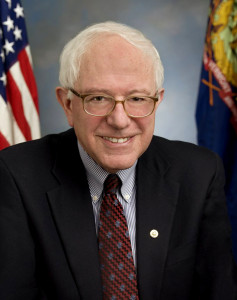
Most people look at Bernie and say that he is too old to be the 45th president. If elected president, he will be the oldest president at 75 years old. The first Google suggestion I received when typing in Bernie Sanders was what was his age. People also point out that before becoming a presidential candidate Sanders was a part of the socialist party before becoming a part of the Democratic Party. While age is important, people shouldn’t count him out of the race for president just because of his age. Like the saying “with age comes wisdom.”
Bernie Sanders has held a seat in political power since 1981 where he became the mayor of Burlington, Vermont. From 1981 till now He has been in some shape or form a part of the government. This alone shows that he has more than enough experience to have what it takes to hold his own in office. Even though his party has changed that does not mean his ideas and experiences changed. He still has the same motives for running as a presidential candidate as a democrat that he had when he was a socialist. With all of his experience he will make a fine president.
Bernie knew he wanted to make a difference politically from a young age. “A guy named Adolf Hitler won an election in 1932. He won an election, and 50 million people died as a result of that election in World War II, including 6 million Jews. So what I learned as a little kid is that politics is, in fact, very important.” Bernie said this quote at a young age. Bernie’s family was affected by the holocausts with many relatives on his father’s side being killed. It was at this moment that Bernie knew that politics where important and he wanted to be a part of them and make a difference for the better and to make sure that something like Hitler being elected does not happen again.
Bernie went to the University of Chicago and studied political science. While at the University of Chicago, Bernie was a part of a few groups/organizations that were involved with politics and political issues. It was through his school that Sanders joined the Socialist party. He was a part of many groups that wanted to change a lot of the laws that affected segregation. In 1962 he led the University of Chicago sit in where a group of students sat outside the university president’s office until he changes the rule that did not allow African American students to live in the same dorm buildings as White students.
Bernie attended the march on Washington in 1963 where Martin Luther King Jr. gave his “I Have a Dream Speech”. In the same year Sanders was arrested in Chicago for protesting with a large group of both White and African American people protesting against segregation. This was just one of the many run ins with the police Sanders has had trying to fight for what he believed to be right.
In 1980 he ran for mayor of Burlington, Vermont and was elected. Where he served as mayor for 4 terms. In 1990 He was elected as a representative in the House. Sanders served in the House from 1991 until he was elected to the Senate in 2006. He still serves the senate to this day.
All of these past experiences should prove to many people that Bernie is a competent candidate and has many important political experiences in his past that have shaped who he his and what he stands for. They have also made him into the presidential candidate we all know today.
In an article posted by The Washington Post today, April 25, Sanders admitted that he will fight to the end even though he knows that in the end Hilary will most likely win due to her large lead in front of him. He said he intends to continue fighting in the race until he finds a reason to quit or the last vote is cast.
Reflection
- The title shows what the article is about and grabs reader’s attention. The lead is creative and clever and draws readers into the text and provides insight with in the first few sentences. Also provides insight into the controversial issue.
- The introduction begins with the controversial issue and goes into further detail as the paragraph goes on. Provide enough background information to understand the controversial topic.
- The writer offers a strong idea and strong evidence that helps the writers point.
- The writer shows clarity of thought and evidence of style in their writing.
- The writer knows that New York Times readers will challenge ideas or underdeveloped ideas so they tried to be as clear as possible and explain everything.
- The controversy is well researched and is developed into a persuasive argument. Much research has been done into topic.
- The writer only used a total of four sources for their assignment.
- The sources are brought up in the assignment by creating a hyperlink to the source in the sentence where the source is being used.
- The writer does a good job persuading the reader about their topic and claims. The writer could have included more arguments for and against their topic.
- The writer has two pictures in there assignment that shows visually what they are talking about.
- The writer shows some improvement on the topic through the peer editing and group editing.
- The writer uses hyperlinks to effectively cite where the information they are talking about is from.
- There are no grammar issues and the writers attention to sentence structure helps establish the writers authority and credibility.
